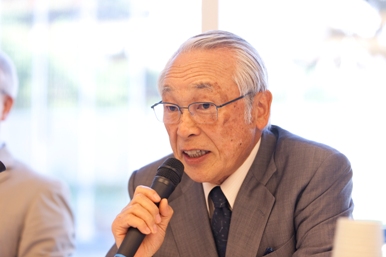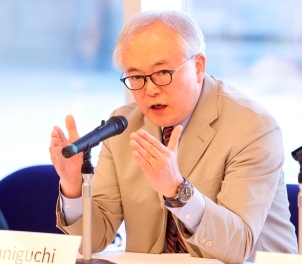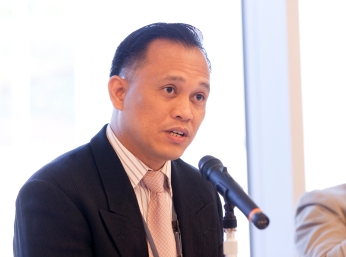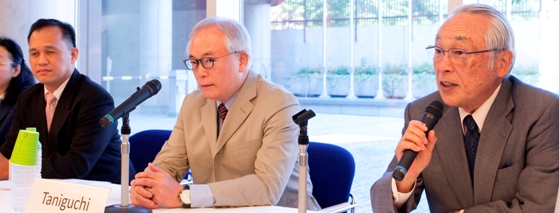- Article
- Comparative and Area Studies
Senkaku and Maritime Security in the Asia-Pacific
August 16, 2013
The second Trilateral Forum Tokyo, co-organized by the Tokyo Foundation and the German Marshall Fund of the United States, was held over the weekend of June 8–9 in Minato-ku, Tokyo, and attracted some 70 leading scholars, think tankers, journalists, government officials, and business representatives from Japan, the United States, and Europe for a Track 1.5 dialogue to explore avenues for further trilateral cooperation and to discuss issues in the Asia-Pacific regional architecture.
A breakfast meeting focusing on “ Senkaku and Maritime Security in the Asia-Pacific” featured three speakers: Tokyo Foundation President Masahiro Akiyama, Cabinet Secretariat Councillor Tomohiko Taniguchi, and Rommel Banlaoi, chairman of the board and executive director of the Philippine Institute for Peace, Violence, and Terrorism Research. The following is a summary of the personal views the three speakers presented at the meeting:
“Sudden Chinese Assertions”
Masahiro Akiyama
China (and Taiwan) began making assertions regarding territorial sovereignty of the Senkaku Islands quite suddenly in 1971, soon after the UN Economic Commission for Asia and the Far East [now the UN Economic and Social Commission for Asia and the Pacific] conducted a survey indicating the possibility of petroleum deposits under the East China Sea in 1968. China never claimed territorial sovereignty of the islands prior to this time.

China says that the islands have been an inherent part of its territory since ancient times. From the standpoint of international law, this amounts to a claim of “historic title” to the islands. Historical documents, such as voyage reports and patrol maps that China has presented as evidence, though, refer to the islands not as Chinese territory but simply as navigation beacons or patrol marks.
The Japanese government began conducting a survey of the Senkaku Islands in 1885, and as a result of a 10-year study, it was confirmed that the islands were not only uninhabited but showed no trace of having been under Chinese control. On January 14, 1895, the Japanese government adopted a cabinet decision formally incorporating the islands into the territory of Japan through an internationally established method for acquiring territorial sovereignty: occupation of terra nullius .
A Japanese resident applied for the lease of the islands—which was approved by the Meiji Government in 1896—and dispatched workers to operate several businesses: collecting bird feathers, manufacturing dried bonito, raising cattle, and manufacturing canned goods. More than 200 people lived and worked on the islands before World War II.
There are many indications that China recognized the islands as being Japanese territory, including a 1920 letter of appreciation from the consul of the Republic of China in Nagasaki; a 1953 article in the People’s Daily ; and a 1958 atlas published by a Chinese map-publishing company.
The Senkaku Islands were not included in the territory that Japan renounced in the San Francisco Peace Treaty. They were placed under US administration as part of the Nansei Shoto Islands and were included in the area whose administrative rights reverted to Japan in accordance with the Okinawa Reversion Agreement of June 17, 1971.
China claims that Japan “stole” the Senkakus during the Sino-Japanese War. The ten-year study the Japanese government conducted was launched before the start of the war. Neither were the islands a part of Taiwan or the Pescadores that were ceded to Japan from China in accordance with the Treaty of Shimonoseki of May 1895 that ended the war.
Good Fences Make Good Neighbors
Tomohiko Taniguchi
Chinese claims that the Senkaku Islands have historically been an inherent part of its territory are belied by absolute silence on this issue for seventy-five-plus years until the early 1970s.

China says they have historical claims to the islands, but history doesn’t really matter. What does matter is that China and Taiwan maintained absolute silence on this issue following Japan’s incorporation of the islands in the late nineteenth century. This was despite China’s invasion of India during the height of the Cuban missile crisis and its ventures into the South China Sea while the United States was struggling with the Vietnam War.
China was also on the brink of war with the Soviet Union and Taiwan. Beijing attempted to expand in all directions between 1949 and 1971, and still it didn’t make any claims on the Senkakus.
The situation around the Senkaku Islands is like having a neighbor who keeps encroaching on your property. Imagine you have a backyard, and one corner of it is a garden called Senkaku. One day, you notice a hole in the fence separating your yard from that of your immediate neighbor. The next day the hole gets a little bigger, allowing your neighbor to come in and out at will. Then suddenly, your neighbor begins claiming and shouting, “The corner garden called Senkaku is mine!”
The Senkaku issue is quite different from the Takeshima dispute, since South Korea doesn’t have expansionist ambitions. Takeshima is an issue between two democracies. Japan has long sought to refer the case to the International Court of Justice. Although South Korea hasn’t responded, Japan is making moves to address the dispute through international rules and international law, even though it knows there’s a chance that it could lose.
China blames Japan for the recent escalation in bilateral tensions, criticizing the central government for its decision to purchase the Senkaku Islands from a private owner and also the attempted purchase by Tokyo Governor Shintaro Ishihara. But the truth of the matter is that this was prompted by increasing threats from Chinese vessels around the islands. The owner approached Ishihara—who was a personal friend—and the central government for help because he wasn’t capable of dealing with the rise in Chinese naval activity around his private property on his own.
The East China Sea dispute can’t be separated from issues in the South China Sea because there are no walls between the maritime areas.
Avoiding Unintentional Conflict
Rommel Banlaoi
The Philippines is embroiled in a similar dispute with China in the South China Sea, so there should be closer coordination among all concerned maritime nations to adopt and adhere to a code of conduct.

The Scarborough Shoal, which we in the Philippines call Panatag Shoal or Bajo de Masinloc Shoal, is 123 nautical miles west of Subic Bay. Under the UN Convention on the Law of the Sea, the shoal is within the Philippines’ 200 nautical mile exclusive economic zone.
China has argued, though, that the shoal, which it calls Huangyan Island, is Chinese territory by virtue of historic rights and effective jurisdiction. It lies within the “nine-dotted line” demarcating China’s claims in the South China Sea, but it’s 472 nautical miles away from Hainan Province. China sent Marine Surveillance vessels Number 84 and 75 in April 2012 with a fleet of at least 12 fishing boats to establish operational control of the area. China declared it’s ready to use force if provoked, since China like all other sovereign states has a right to self-defense.
To avoid unintentional conflict with China, the Philippines no longer deploys its Coast Guard ships in the area. Fishermen are also discouraged from fishing there as a preventive measure. With limited military and law enforcement capabilities to protect its claims, the Philippine government submitted in January 2013 its maritime claim to the International Tribunal on the Law of the Sea. But China vehemently rejected the submission and ignored the case, blaming the Philippines for suing a “close and good neighbor” and claiming that China has been hurt.
While China seeks to convince international society that it wants a peaceful external security environment, the increased deployment of paramilitary forces has raised concern among the region’s littoral states and countries relying on the freedom of navigation in the South China Sea, which is one of the world’s busiest sea lanes. The countries are worried that China’s “reactive assertiveness” in pursuing its maritime territorial claims will increase the potential of a military conflict in this highly contested maritime domain.
Asia’s rising maritime nationalism can further complicate the situation. Avoiding violent accidents in contested areas, which can severely threaten maritime security, peace, stability, and prosperity in the Asia-Pacific region, should loom large in the strategic thinking, policymaking, and tactical operations of countries in the region.

